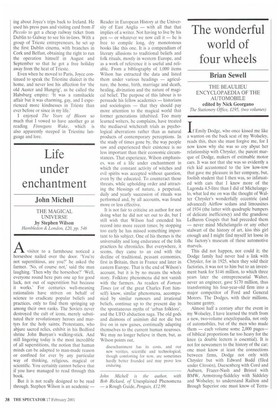Life under enchantment
John Michell
THE MAGICAL UNIVERSE
by Stephen Wilson
Hambledon & London. £20, pp. 546
Avisitor to a farmhouse noticed a horseshoe nailed over the door. 'You're not superstitious, are you?' he asked the farmer. 'No, of course not,' said the man laughing. 'Then why the horseshoe?"Well, everyone round here puts one up for good luck, not out of superstition but because it works.' For centuries well-meaning rationalists have striven on behalf of science to eradicate popular beliefs and practices, only to find them springing up among their own ranks. The Soviets never destroyed the cult of icons, merely substituted their revolutionary heroes and martyrs for the holy saints; Protestants, who abjure sacred relics, exhibit in his Bedford shrine John Bunyan's walking-stick. And still lingering today is the most incredible of all superstitions, the notion that human minds can be adapted to man-made reason or confined for ever by any particular way of thinking, religious, magical or scientific. You certainly cannot believe that if you have managed to read through this book.
But it is not really designed to be read through. Stephen Wilson is an academic — Reader in European History at the University of East Anglia — with all that that implies of a writer. Not having to live by his pen — or whatever we now call it — he is free to compile long, dry monotonous books like this one. It is a compendium of literary allusions to traditional beliefs and folk rituals, mostly in western Europe, and as a work of reference it is useful and reliable. From a bibliography of 1,000 items Wilson has extracted the data and listed them under various headings — agriculture, the home, birth, marriage and death, healing, divination and the nature of magical belief. The purpose of this labour is to persuade his fellow academics — historians and sociologists — that they should pay more attention to the magical world that former generations inhabited. Too many learned writers, he complains, have treated the mediaeval witchcraft trials as psychological aberrations rather than as natural products of contemporary perceptions. In the study of times gone by, the way people saw and experienced their existence is no less important than their economic circumstances. That experience, Wilson emphasises, was of a life under enchantment in which the constant activity of witches and evil spirits was accepted without question, even by the educated. To counteract those threats, while upholding order and attracting the blessings of nature, a perpetual, daily and yearly succession of rituals was performed and, by all accounts, was found more or less effective.
It is not fair to criticise an author for not doing what he did not set out to do, but I still wish that Wilson had extended his record into more recent times; by stopping too early he has missed something important to his subject. One of his themes is the universality and long endurance of the folk practices he chronicles. But everywhere, it seems, they came to an end with the decline of traditional, peasant economies, first in Britain, then in France and later in eastern Europe. That is the end of Wilson's account, but it is by no means the whole story. Folklore phenomena did not vanish with the farmers. As readers of Fortean Times (or of the great Charles Fort himself) know, similar phenomena, accompanied by similar rumours and irrational beliefs, continue up to the present day in the spontaneous myths of 'urban folklore', and the UFO abduction saga. The old gods and daimons of animism did not die but live on in new guises, continually adapting themselves to the current human neuroses. We may no longer believe in them, but, as Wilson points out,
disenchantment has its costs, and our new verities, scientific and technological, though comforting for now, are sometimes hardly better founded and may prove less enduring.
John Michell is the author, with Bob Rickard, of Unexplained Phenomena — a Rough Guide, Penguin, .EI2.99.


































































 Previous page
Previous page